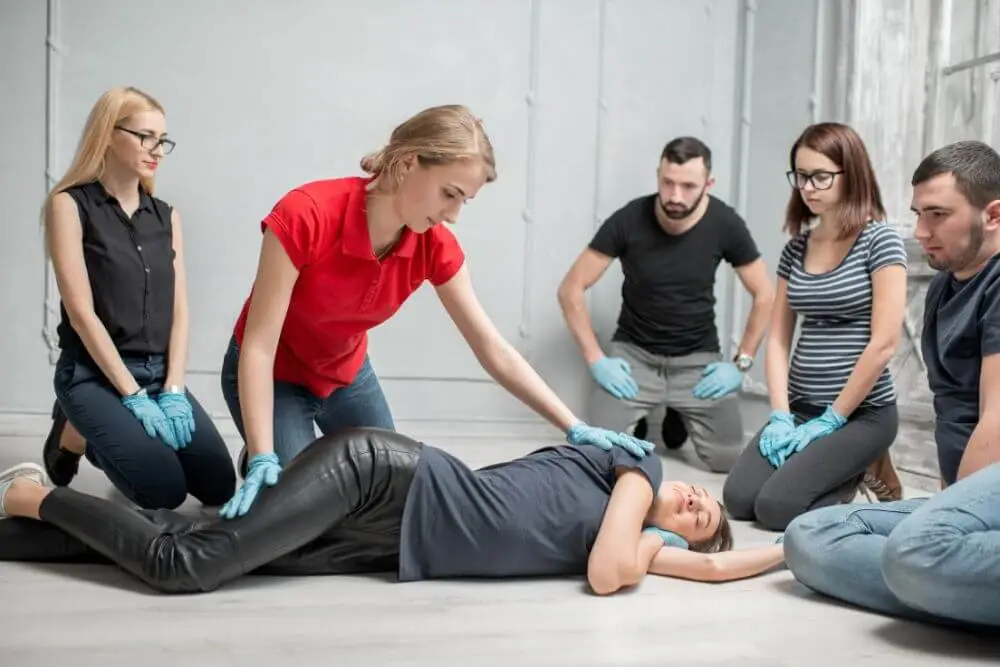International Award In Emergency First Aid At Work Level 2
This accredited qualification is ideal for those already working or preparing to work within the industry and wishing to become a First Aider.
4.9 (7,439 Ratings)
Course Features
What you’ll learn
This accredited qualification is ideal for those already working or preparing to work within industry wishing to become a First Aider in the workplace for the purposes of the Health and Safety (First Aid) Regulations 1981 and the Health and Safety (First Aid) Regulations (NI) 1982.
All successful students will be issued with a First Aid at Work Certificate, along with a wallet-sized plastic card detailing their qualification.
Overview
This qualification is typically delivered as a one day program and aimed at learners already working or preparing to work in industry that is identified within the company’s risk assessment of First Aid.
Topics within this course are regarded by the Health & Safety Executive as being important in maintaining good practice in the safe, prompt and effective treatment of injuries and ill health in the workplace.
This accredited qualification is ideal for those already working or preparing to work within industry wishing to become a First Aider in the workplace for the purposes of the Health and Safety (First Aid) Regulations 1981 and the Health and Safety (First Aid) Regulations (NI) 1982.
1. Understand the role and responsibilities of a first aider
- Identify the role and responsibilities of a first aider
- Describe how to minimise the risk of infection to self and others
- Identify the need of establishing consent to provide first aid
- Complete an accident report form
- Identify the first aid equipment that should be available in a workplace
- Describe the safe use of first aid equipment
2. Be able to assess an incident
- Conduct a scene survey
- Conduct a primary survey of a casualty
- Give examples of when to call for help
3. Be able to manage an unresponsive casualty who is breathing normally
- Assess a casualty’s level of consciousness
- Open a casualty’s airway and check breathing
- Explain why it is important to place an unconscious casualty into the recovery position
- Place an unresponsive casualty in the recovery position
- Manage a casualty who is in seizure
4. Be able to manage an unresponsive casualty who is not breathing normally
- Recognise the need to commence Cardio Pulmonary Resuscitation
- Demonstrate Cardio Pulmonary Resuscitation using a manikin
5. Know how to recognise and assist a casualty who is choking
- Describe how to identify a casualty with a Partially blocked airway & Completely blocked airway
- Administer first aid to a casualty who is choking
6. Be able to manage a casualty
- Identify the types of external bleeding with external bleeding
- Control external bleeding
7. Be able to manage a casualty who is in shock
- Recognise shock
- Administer first aid to a casualty who is in shock
8. Be able to manage a casualty with a minor injury
- Administer first aid to a casualty with small cuts, grazes and bruises
- Administer first aid to a casualty with minor burns and scalds
- Administer first aid to a casualty with small splinters
In order to register on to this qualification, learners are required to meet the following entry requirements:
16 years of age or above
The assessment of this unit includes:
1] Practical observation
The practical assessment of learners for the qualification is completed throughout the course delivery. This ongoing assessment will involve learners demonstrating practical first-aid skills across several areas.
2] Written/Oral questioning
The oral examination component of this qualification will be completed via ongoing questioning/discussion with learners on the course. This assessment will require learners to demonstrate their knowledge and understanding in several first aid-related areas.
Related Courses
In addition to the topics covered in this course, many other related courses can provide additional information and resources. Here are some popular ones.
12+
Years Of Experience
15K+
Qualified Students
10+
Certified Trainers
100+
Courses & Programs
Testimonials
What Students are Saying
Check out our students’ testimonials and know how our institution has created a mark in the arena of professional education & training.
The Future Belongs To Those Who See Possibilities Today
At Safety Institute Pakistan, we understand the importance of preparing for the future. We strive to provide our students with quality education and training that will equip them with the skills and knowledge needed to be successful in their fields.
We are dedicated to helping our students find career success, so they can positively contribute to society. With our courses and qualifications, we are sure that you will be able to find success in your career path.








